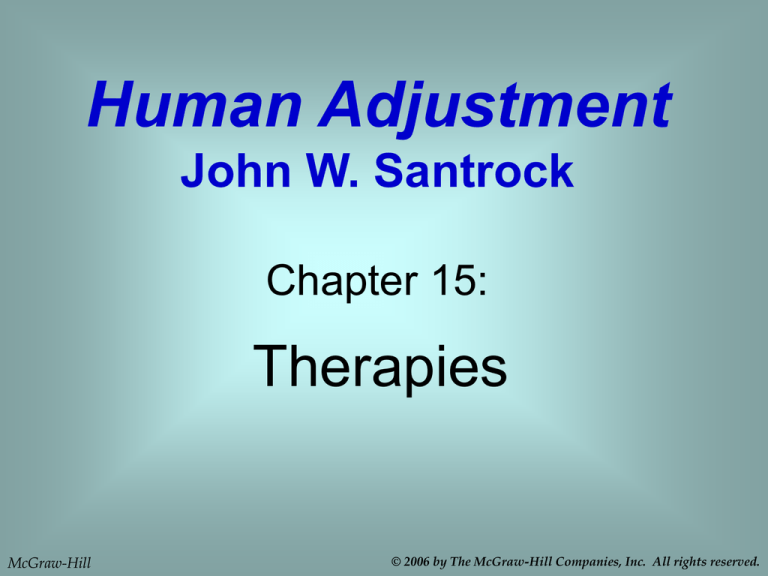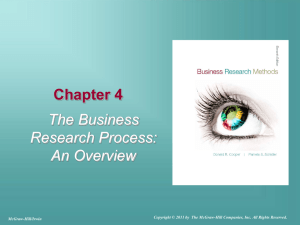
Human Adjustment
John W. Santrock
Chapter 15:
Therapies
McGraw-Hill
© 2006 by The McGraw-Hill Companies, Inc. All rights reserved.
15-2
Chapter Outline
Biological Therapies
Psychotherapies
Sociocultural Approaches and Issues in Treatment
Evaluating Therapy
McGraw-Hill
©2006 by the McGraw-Hill Companies, Inc. All rights reserved.
15-3
Learning Goals
1. Describe the biological therapies
2. Characterize four types of psychotherapy
3. Explain sociocultural approaches and issues in
treatment
4. Evaluate the effectiveness of therapy
McGraw-Hill
©2006 by the McGraw-Hill Companies, Inc. All rights reserved.
15-4
BIOLOGICAL THERAPIES
Drug therapy
Electroconvulsive Therapy
Psychosurgery
McGraw-Hill
©2006 by the McGraw-Hill Companies, Inc. All rights reserved.
15-5
Therapy
Biological therapy = treatment to reduce or
eliminate symptoms of psychological disorders by
altering the way an individual’s body functions
Psychotherapy = process used by mental health
professionals to help individuals recognize, define,
an overcome psychological and interpersonal
difficulties
McGraw-Hill
©2006 by the McGraw-Hill Companies, Inc. All rights reserved.
15-6
Drug Therapy - Antianxiety Drugs
Antianxiety drugs = commonly known as
tranquilizers; drugs that reduce anxiety by making
individuals calmer and less excitable
McGraw-Hill
©2006 by the McGraw-Hill Companies, Inc. All rights reserved.
15-7
Drug Therapy - Antianxiety Drugs
Benzodiazepines - relieve anxiety symptoms by
binding to receptor sites of neurotransmitters that
become overactive during anxiety
– Most frequently prescribed benzodiazepines include Xanax,
Valium, Librium
– Side-effects of benzodiazepines include addiction,
drowsiness, loss of coordination, fatigue
McGraw-Hill
©2006 by the McGraw-Hill Companies, Inc. All rights reserved.
15-8
Drug Therapy - Antidepressant Drugs
Antidepressant drugs = drugs that regulate mood
McGraw-Hill
©2006 by the McGraw-Hill Companies, Inc. All rights reserved.
15-9
Drug Therapy - Antidepressant Drugs
Three main classes of antidepressant drugs:
– tricyclics (Elavil) - increase norepinephrine and serotonin
– MAO inhibitors (Nardil) - not as widely used because of
interactions
– SSRI drugs (Prozac, Paxil, Zoloft) - inhibit reabsorption of
serotonin (selective serotonin reuptake inhibitors)
McGraw-Hill
©2006 by the McGraw-Hill Companies, Inc. All rights reserved.
Figure 15.1 How the
Antidepressant Prozac Works
McGraw-Hill
15-10
©2006 by the McGraw-Hill Companies, Inc. All rights reserved.
15-11
Drug Therapy - Lithium
Lithium = drug used to treat bipolar disorder
Lithium helps reduce mood swings
McGraw-Hill
©2006 by the McGraw-Hill Companies, Inc. All rights reserved.
15-12
Drug Therapy - Antipsychotic Drugs
Antipsychotic drugs = drugs that diminish agitated
behavior, reduce tension, decrease hallucinations,
improve social behavior, and produce better sleep
patterns in individuals who have a severe psychological
disorder, especially schizophrenia
McGraw-Hill
©2006 by the McGraw-Hill Companies, Inc. All rights reserved.
15-13
Drug Therapy - Antipsychotic Drugs
Neuroleptics are the most widely used antipsychotic
drugs
– reduce level of the neurotransmitter dopamine in the brain
Atypical antipsychotic drugs block reuptake of
serotonin
– Two atypical antipsychotic drugs include Clozaril and
Risperdal
McGraw-Hill
©2006 by the McGraw-Hill Companies, Inc. All rights reserved.
15-14
Electroconvulsive Therapy (ECT)
Electroconvulsive therapy = treatment used to
treat severely depressed individuals; treatment
causes seizure in the brain
Patient is given anesthesia and muscle relaxants
before treatment, so patient has no memory of it
ECT is effective for these who do not respond to other
therapies
McGraw-Hill
©2006 by the McGraw-Hill Companies, Inc. All rights reserved.
15-15
Psychosurgery
Psychosurgery = biological therapy that involves removal
of brain tissue to improve individual’s adjustment
McGraw-Hill
©2006 by the McGraw-Hill Companies, Inc. All rights reserved.
15-16
Review - Learning Goal 1
– What types of drugs are most often used to treat anxiety
disorders, mood disorders, and schizophrenia?
– What is electroconvulsive therapy and when is it used?
– What is psychosurgery?
McGraw-Hill
©2006 by the McGraw-Hill Companies, Inc. All rights reserved.
15-17
PSYCHOTHERAPIES
Psychodynamic Therapies
Humanistic Therapies
Behavior Therapies
Cognitive Therapies
Integrative Therapy
McGraw-Hill
©2006 by the McGraw-Hill Companies, Inc. All rights reserved.
15-18
Psychodynamic Therapies
Psychodynamic therapies = therapies that stress
importance of unconscious mind, extensive interpretation
by the therapist, and the role of early childhood years
Goal of psychodynamic therapies is to help
individuals recognize maladaptive ways of coping and
the sources of their unconscious conflicts
McGraw-Hill
©2006 by the McGraw-Hill Companies, Inc. All rights reserved.
15-19
Freud’s Psychoanalysis
Psychoanalysis = Freud’s psychotherapeutic
technique for analyzing an individual’s unconscious
thoughts
Client’s current problems can be traced to early
childhood experiences involving conflicts
Interpretation important - therapist searches for
symbolic, hidden meaning
McGraw-Hill
©2006 by the McGraw-Hill Companies, Inc. All rights reserved.
15-20
Freud’s Psychoanalysis
Free association - psychoanalytic technique of having
individuals say aloud whatever comes to mind
Catharsis - release of emotional tension when reliving
emotionally charged and conflict-filled experience
Dream analysis - psychotherapeutic technique used
by psychoanalysts to interpret a dream
– Psychoanalysts believe dreams contain information about
individual’s unconscious thoughts and conflicts
McGraw-Hill
©2006 by the McGraw-Hill Companies, Inc. All rights reserved.
Figure 15.4 Freudian Interpretation of
Sexual Symbolism in Dreams
McGraw-Hill
15-21
©2006 by the McGraw-Hill Companies, Inc. All rights reserved.
15-22
Freud’s Psychoanalysis
Resistance - psychoanalytic term for person’s
unconscious defense strategies that prevent analyst
from understanding the person’s problems
– Resistance occurs because it is painful to bring conflicts
into conscious awareness
McGraw-Hill
©2006 by the McGraw-Hill Companies, Inc. All rights reserved.
15-23
Freud’s Psychoanalysis
Transference - psychoanalytic term for person’s
relation to the analyst in ways that relive important
relationships in the person’s life
– Transference can reveal how individuals relate to important
people in their lives
McGraw-Hill
©2006 by the McGraw-Hill Companies, Inc. All rights reserved.
15-24
Contemporary Psychodynamic Therapies
Today, individuals in psychodynamic therapy:
– face the therapist
– have weekly appointments
– undergo therapy for a shorter period of time
McGraw-Hill
©2006 by the McGraw-Hill Companies, Inc. All rights reserved.
15-25
Contemporary Psychodynamic Therapies
Currently, psychodynamic therapists emphasize (in
addition to the unconscious mind):
– the conscious mind
– relationships
– social contexts
McGraw-Hill
©2006 by the McGraw-Hill Companies, Inc. All rights reserved.
Adjustment Strategies
Based on Psychodynamic Therapies
15-26
1. Recognize that the reasons for your good or poor
adjustment are likely beyond conscious awareness
2. Examine your childhood experiences in your family
3. Explore whether you are relying too heavily on
defense mechanisms
4. Realize that different psychodynamic therapies offer
different approaches to adjustment
McGraw-Hill
©2006 by the McGraw-Hill Companies, Inc. All rights reserved.
15-27
Humanistic Therapies
Insight therapy = therapy that encourages insight and
self-awareness; includes both psychodynamic and
humanistic therapies
McGraw-Hill
©2006 by the McGraw-Hill Companies, Inc. All rights reserved.
15-28
Humanistic Therapies
Humanistic therapies = insight therapies that encourage
people to understand themselves and to grow
personally
Humanistic therapies emphasize:
– conscious rather than unconscious thought
– the present rather than the past
– growth and self-fulfillment rather than illness
McGraw-Hill
©2006 by the McGraw-Hill Companies, Inc. All rights reserved.
15-29
Client-Centered Therapy
Client-centered therapy = Rogers’ humanistic therapy
in which the therapist provides a warm, supportive
atmosphere to improve the client’s self-concept and
encourage the client to gain insight about problems
Developed by Carl Rogers (1961)
McGraw-Hill
©2006 by the McGraw-Hill Companies, Inc. All rights reserved.
15-30
Client-Centered Therapy
Unconditional positive regard - therapist creates a
warm and caring environment and never disapproves
of the client
Therapist’s role is nondirective
In addition to unconditional positive regard, clientcentered therapy involves:
– genuineness - let client know therapist’s feelings
– active listening - give total attention to what person says
McGraw-Hill
©2006 by the McGraw-Hill Companies, Inc. All rights reserved.
15-31
Gestalt Therapy
Gestalt therapy = Perl’s humanistic therapy in which the
therapist challenges the client to help them become
aware of their feelings and to face their problems
Developed by Fritz Perls (1969)
Therapist pushes clients to decide whether they will
continue to allow the past to control their future
McGraw-Hill
©2006 by the McGraw-Hill Companies, Inc. All rights reserved.
15-32
Gestalt Therapy
Gestalt therapists encourage clients to:
– be open about their feelings
– develop self-awareness
– be themselves
– develop a sense of freedom
– look at what they are doing with their lives
To stimulate change, therapist often openly confronts
client
McGraw-Hill
©2006 by the McGraw-Hill Companies, Inc. All rights reserved.
15-33
Behavior Therapies
Behavior therapies = use principles of learning to
reduce or eliminate maladaptive behavior
Behavior therapists offer action-oriented strategies to
help people change what they are doing
The maladaptive symptoms are the problem
McGraw-Hill
©2006 by the McGraw-Hill Companies, Inc. All rights reserved.
15-34
Applications of Classical Conditioning
Systematic Desensitization = treats anxiety by
getting the person to associate deep relaxation with
increasingly intense anxiety-producing situations
Systematic desensitization steps include:
– develop a hierarchy of least fearful to most fearful situation
to teach the individual how to relax
– start at the lower end of the hierarchy and work your way up
McGraw-Hill
©2006 by the McGraw-Hill Companies, Inc. All rights reserved.
15-35
Applications of Classical Conditioning
Aversive conditioning = repeated pairings of
an undesirable behavior with aversive stimuli
to decrease the behavior’s rewards
Aversive conditioning - used to teach people to avoid
behaviors such as smoking, eating, and drinking
McGraw-Hill
©2006 by the McGraw-Hill Companies, Inc. All rights reserved.
15-36
Figure 15.6 Classical Conditioning: the
Backbone of Aversive Conditioning
McGraw-Hill
©2006 by the McGraw-Hill Companies, Inc. All rights reserved.
15-37
Applications of Operant Conditioning
Behavior modification = application of operant
conditioning principles to change human behaviors,
especially to replace unacceptable, maladaptive
behavior with acceptable adaptive behaviors
McGraw-Hill
©2006 by the McGraw-Hill Companies, Inc. All rights reserved.
15-38
Applications of Operant Conditioning
Token economy - system in which desired behaviors
are reinforced with tokens that later can be exchanged
for desired rewards
Token economies are used in:
– classrooms
– institutions for the mentally retarded
McGraw-Hill
©2006 by the McGraw-Hill Companies, Inc. All rights reserved.
15-39
Cognitive Therapies
Cognitive therapies = emphasize that the individual’s
cognitions are the main source of abnormal behavior
and psychological problems
Cognitive therapies:
– focus more on overt symptoms
– provide structure to individual’s thoughts
– are less concerned about origin of problem
McGraw-Hill
©2006 by the McGraw-Hill Companies, Inc. All rights reserved.
15-40
Cognitive Therapies
Cognitive therapists:
– aim for cognitive restructuring (changing a pattern of
thought)
– guide individuals to identify irrational and self-defeating
thoughts
– use techniques to help clients:
-challenge these thoughts
-consider different, more positive ways of thinking
McGraw-Hill
©2006 by the McGraw-Hill Companies, Inc. All rights reserved.
15-41
Rational-Emotive Behavior Therapy
Rational-emotive behavior therapy (REBT) = based on
Albert Ellis’ assertion that individuals develop a
psychological disorder because of their beliefs,
especially those that are irrational and self-defeating
Goal of REBT is to get person to eliminate selfdefeating beliefs by rationally examining them
McGraw-Hill
©2006 by the McGraw-Hill Companies, Inc. All rights reserved.
15-42
Beck’s Cognitive Therapy
Aaron Beck’s (1976) cognitive therapy resembles an
open-ended dialogue in which the therapist helps
individuals to:
– reflect on personal issues
– discover their own misconceptions
– try out unbiased experiments that reveal the inaccuracies of
their beliefs
McGraw-Hill
©2006 by the McGraw-Hill Companies, Inc. All rights reserved.
15-43
Beck’s Cognitive Therapy
Illogical thinking can lead an individual to errors:
– perceive world as harmful
– overgeneralize on the basis of limited examples
– Magnify the importance of undesirable events
– engage in absolutist thinking
McGraw-Hill
©2006 by the McGraw-Hill Companies, Inc. All rights reserved.
Adjustment Strategies
Based on Beck’s Cognitive Therapy
15-44
1. Keep records of thoughts and emotional reactions
2. Engage in thought stopping
3. Examine options and alternatives
4. Question the evidence
5. Become positively distracted
6. Decatastrophize
7. Fantasize consequences
8. Turn adversity into advantage
McGraw-Hill
©2006 by the McGraw-Hill Companies, Inc. All rights reserved.
15-45
Cognitive Behavior Therapy
Cognitive behavior therapy = consists of a combination
of cognitive therapy and behavior therapy
Self-efficacy is an important goal of cognitive behavior
therapy
McGraw-Hill
©2006 by the McGraw-Hill Companies, Inc. All rights reserved.
Adjustment Strategies
Self-Instructional Methods
15-46
1. Preparing for stress or anxiety
2. Confronting and handling anxiety or stress
3. Coping with feelings at critical moments
4. Reinforcing self-statements
McGraw-Hill
©2006 by the McGraw-Hill Companies, Inc. All rights reserved.
15-47
Integrative Therapy
Integrative therapy = combination of techniques from
different therapies based on the therapist’s judgment
of which particular techniques will provide the greatest
benefit for the client
McGraw-Hill
©2006 by the McGraw-Hill Companies, Inc. All rights reserved.
15-48
Integrative Therapy
Move toward integrative therapy includes factors
such as:
– proliferation of therapies
– inadequacy of a single therapy to be relevant to all clients
and all problems
– lack of evidence that one therapy is better than others
– recognition that therapy commonalities play an important
role in therapy outcomes
McGraw-Hill
©2006 by the McGraw-Hill Companies, Inc. All rights reserved.
15-49
Review - Learning Goal 2
– What is psychodynamic therapy?
– How do the humanistic therapies of Rogers and Perls
differ?
– How are classical conditioning and operant conditioning
applied in behavior therapies?
– What are the characteristics of RMBT, Beck’s cognitive
therapy, and cognitive-behavior therapy?
– What is integrative therapy?
McGraw-Hill
©2006 by the McGraw-Hill Companies, Inc. All rights reserved.
SOCIOCULTURAL APPROACHES
AND ISSUES IN TREATMENT
15-50
Group Therapy
Family and Couple Therapy
Self-Help Support Groups
Community Mental Health
Cultural Perspectives
McGraw-Hill
©2006 by the McGraw-Hill Companies, Inc. All rights reserved.
15-51
Group Therapy
Features that make group therapy attractive:
– Information - from leader and others in group
– Universality - learning that others have similar problems
– Altruism - members support one another
– Corrective recapitulation of the family group
– Development of social skills - give and receive feedback
– Interpersonal learning - practice new behaviors
McGraw-Hill
©2006 by the McGraw-Hill Companies, Inc. All rights reserved.
15-52
Family and Couples Therapy
Family therapy - group therapy with family members
Couples therapy - therapy with married or unmarried
couples whose major problem is their relationship
Although one person may have abnormal symptoms,
symptoms are a function of the family or couple
McGraw-Hill
©2006 by the McGraw-Hill Companies, Inc. All rights reserved.
Adjustment Strategies
Based on Family Therapy
15-53
1. Validation
2. Reframing
3. Structural change
4. Detriangulation
McGraw-Hill
©2006 by the McGraw-Hill Companies, Inc. All rights reserved.
15-54
Self-Help Support Groups
Self-help groups - voluntary organizations of
individuals who get together on a regular basis to
discuss topics of common interest
– Groups are led by a paraprofessional or member of the
common interest group
– Self-help support groups provide members with sympathetic
audience for confession and emotional release
– Alcoholics Anonymous (AA) is one of the best-known selfhelp groups
McGraw-Hill
©2006 by the McGraw-Hill Companies, Inc. All rights reserved.
Adjustment Strategies for Benefiting
from Self-Help Support Groups
15-55
1. The effectiveness of self-help support groups
depends on local members
2. Learn more about how self-help groups work
3. Find out about the self-help support groups available
in your community
4. If a self-help support group that deals with a topic in
which you are interested in is not available, start one
yourself
McGraw-Hill
©2006 by the McGraw-Hill Companies, Inc. All rights reserved.
15-56
Community Mental Health
Through the community mental health movement,
mental health professionals have tried to extend the
reach of therapeutic efforts
The community mental health approach includes
teachers, ministers, and family physicians who interact
with community members to offer lay-counseling and
workshops on topics such as stress, reducing drug
use, and using assertiveness training
McGraw-Hill
©2006 by the McGraw-Hill Companies, Inc. All rights reserved.
15-57
Cultural Perspectives
Traditional psychotherapies (psychodynamic,
humanistic, behavioral, cognitive) focus on individual
– The individual approach may not be effective in collectivist
cultures
McGraw-Hill
©2006 by the McGraw-Hill Companies, Inc. All rights reserved.
15-58
Ethnicity
Many ethnic-minority individuals prefer discussing
problems with parents, friends, and relatives rather
than mental health professionals
When therapist and client are from the same ethnic
background, therapy can be more effective
McGraw-Hill
©2006 by the McGraw-Hill Companies, Inc. All rights reserved.
15-59
Gender
Traditionally, therapy has focused on autonomy or selfdetermination (especially important for men)
Recently, more emphasis on relatedness and
connection to others (especially important for women)
Feminist therapists believe women must become
aware of bias and discrimination in their own lives
McGraw-Hill
©2006 by the McGraw-Hill Companies, Inc. All rights reserved.
15-60
Review - Learning Goal 3
– What is group therapy?
– What characterizes family and couples therapy?
– What are some important features of self-help support
groups?
– How can the community mental health approach be
described?
– How might ethnicity and gender affect the success of
psychotherapy?
McGraw-Hill
©2006 by the McGraw-Hill Companies, Inc. All rights reserved.
15-61
EVALUATING THERAPY
Is Therapy Effective?
Common Themes in Effective Psychotherapy
Funding Therapy
Selecting a Therapist
McGraw-Hill
©2006 by the McGraw-Hill Companies, Inc. All rights reserved.
15-62
Is Therapy Effective?
Hans Eysenck (1952) concluded that psychotherapy
was ineffective
– He found two-thirds of people with neurotic symptoms
improved, whether or not they received therapy
McGraw-Hill
©2006 by the McGraw-Hill Companies, Inc. All rights reserved.
15-63
Is Therapy Effective?
More people receiving psychotherapy improve as
compared to people who do not receive therapy
Cognitive therapies and behavior therapies - help in
anxiety disorders
Cognitive therapies and behavior therapies - help in
depression
Relaxation therapy - help in treating anxiety
McGraw-Hill
©2006 by the McGraw-Hill Companies, Inc. All rights reserved.
Common Themes in
Effective Psychotherapy
15-64
Effective therapies share three elements:
– inspire positive expectations
– increase the client’s sense of mastery and competence
– arouse the individual’s emotions
McGraw-Hill
©2006 by the McGraw-Hill Companies, Inc. All rights reserved.
15-65
Funding Therapy
Therapy can be expensive
Many who need therapy do not get it
Managed care tries to cut costs
McGraw-Hill
©2006 by the McGraw-Hill Companies, Inc. All rights reserved.
15-66
Selecting a Therapist
Psychotherapy is practiced by a variety of mental
health professionals, including clinical psychologists,
psychiatrists, and counselors
– Different types of mental health professionals take different
approaches
– Licensing and certification require mental health
professionals to engage in ethical practices
McGraw-Hill
©2006 by the McGraw-Hill Companies, Inc. All rights reserved.
Adjustment Strategies
for Seeking Professional Help
15-67
1. Become informed about the services offered by
therapists
2. Consider which characteristics of a therapist are
important to you
3. Identify the professional’s credentials
4. Give therapy some time
5. If your goals are not being met, find a new therapist
6. Continually evaluate your progress
McGraw-Hill
©2006 by the McGraw-Hill Companies, Inc. All rights reserved.
15-68
Review - Learning Goal 4
– How effective is therapy?
– What are some common themes in psychotherapy?
– What kinds of health professionals are qualified to provide
mental health treatment?
– What role is managed care playing in mental health
treatment?
McGraw-Hill
©2006 by the McGraw-Hill Companies, Inc. All rights reserved.









